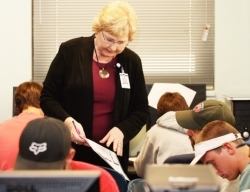Adjunct professors are key staff at college
By Phyllis Moore
Published in News on October 21, 2013 1:46 PM

News-Argus/CASEY MOZINGO
Adjunct professor Dianne Hooks assists students in her agricultural accounting class at Wayne Community College on Thursday. She has been teaching at the college for three years. The college employs part-time instructors to supplement its teaching pool and provide additional options for course offerings.

News-Argus/CASEY MOZINGO
Student Judy Davenport, left, watches as continuing education instructor Joan Edwards demonstrates a painting technique at Wayne Community College. Ms. Edwards is a part-time instructor in the continuing education program.
Part-time, or adjunct, professors are a critical part of the instructional arm of Wayne Community College, like they are at many other community colleges across the state.
"They can teach anything and what we do is balance our full-time and part-time in each of the departments. In some of the departments, full-timers may teach every course, but an adjunct may step in for any course," Dr. Peggy Teague said. She is the vice president for academic services at the college.
Adjunct professors usually come highly qualified, Ms. Teague said. They might even hold the same degree as the tenured professors, or at least equitable credentials.
"In some disciplines on this campus, like geography, we don't have a full-time person," she said. "We don't have the demand for it, but have part-timers for that. They're really a critical part to rounding out our offerings in (fields where) we don't have full-time professors.
In 2010, 73 percent of the college's courses were taught by full-time instructors. The same year, the state's community college's rate was 65 percent.
"We do a little better with our average than the average community college," Ms. Teague said. "With full-time, you have the added expense of benefits. We simply can't afford to have all full-time.
"In some cases, particularly with simulation and gaming, we might be able to hire a highly specialized professor to teach a course. Sometimes there are unique characteristics. Sometimes it's a class that they just don't have a full-timer to fill."
The reliance on adjunct instructors is nothing new. Ms. Teague said three years ago the college had 199 faculty members, 103 of whom were full-time and 96 part-time. The school is now up to about 110-115 full-time instructors.
But that's just the curriculum program, she noted.
"There's many more, with continuing education and basic skills (programs)," she said. "In other areas, in continuing education, primarily basic skills, that includes the adult high school, we have some part-time and some full-time."
With continuing education, or occupational extension -- programs like welding, electric wiring, cabinet-making -- where students enroll to enrich their skills, classes can often be handled by part-time professors. The same holds true for more recreational offerings such as painting, quilting and yoga.
"The courses originate because there's community interest in it," Ms. Teague said. "We just find the instructors with the credentials. It varies, depending on the subject area. With curriculum, the credentials are defined.
"Jewelry-making may be someone that doesn't have the educational background but they're crafty and they have learned from other people and can lead the class."
The part-time instructors do not receive benefits and they do not serve on faculty committee or perform academic advising.
And in the case of online courses, they don't even have to be local.
"There are areas that are difficult to find suitable applicants in the Wayne County area but there are plenty of people in Raleigh," Ms. Teague said. "Sometimes we have to reach out to places that are geographically (convenient)."
Likewise, candidates for adjunct professor have varied reasons for doing so -- from newly minted graduates unable to find a full-time job to retirees or seasoned faculty members with specialty skills.
"There are ones that have done it for several years and that may want part-time. There are people who teach at multiple colleges," Ms. Teague said. "We're much more conservative about how we allow our part-timers to teach. We try to keep it about half of what the full-time teach. In 2010, the average (part-time) hours were eight.
"Other schools may allow them to teach more, or if they're wanting to do this part-time and produce the FTE (full-time equivalent) salary they may teach two or three classes for us and two or three at a sister institution."
The option is also beneficial for the clientele served by WCC, where the average student age is 27. Many are already working and juggling family responsibilities, returning to the work force or obtaining advanced training.
So, Ms. Teague said, providing night courses and supplemental classes not only benefits students but the college economy as well.
"We have been in extremely tight budget years for years," she said. "We did not approve any new faculty positions this year. So we focus the demands on part-time.
"We're serving more students at basically the same dollars."
Despite a weakened economy and increases in the costs of tuition and textbooks, curriculum enrollment at WCC has gone up every year.
"Our statistics show that we have more part-timers teaching online," Ms. Teague said. "Adjunct professors are critical to the college. We use part-time every term, less in the summer because we offer less in the summer."
